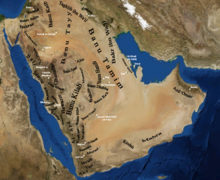A | B | C | D | E | F | G | H | CH | I | J | K | L | M | N | O | P | Q | R | S | T | U | V | W | X | Y | Z | 0 | 1 | 2 | 3 | 4 | 5 | 6 | 7 | 8 | 9
Muhammad | |
|---|---|
مُحَمَّد | |
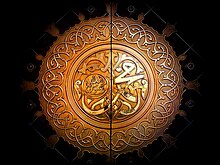 | |
| Personal | |
| Born | c. 570 CE (53 BH)[1] |
| Died | 8 June 632 (11 AH) (aged 61–62) Medina, Hejaz, Arabia |
| Resting place | Green Dome at al-Masjid an-Nabawi, Medina, Arabia 24°28′03″N 39°36′41″E / 24.46750°N 39.61139°E |
| Spouse | See Muhammad's wives |
| Children | See Muhammad's children |
| Parent(s) | Abdullah ibn Abd al-Muttalib (father) Amina bint Wahb (mother) |
| Known for | Founding Islam |
| Other names |
|
| Relatives | Family tree of Muhammad, Ahl al-Bayt ("Family of the House") |
| Arabic name | |
| Personal (Ism) | Muḥammad |
| Patronymic (Nasab) | Muḥammad ibn ʿAbd Allāh ibn ʿAbd al-Muṭṭālib ibn Hāshim ibn ʿAbd Manāf ibn Quṣayy ibn Kilāb |
| Teknonymic (Kunya) | ʾAbu al-Qāsim |
| Epithet (Laqab) | Khātam an-Nabiyyīn (Seal of the Prophets) |
| Part of a series on |
| Muhammad |
|---|
 |
Muhammad[a] (Arabic: مُحَمَّد; c. 570 – 8 June 632 CE)[b] was an Arab religious, social, and political leader and the founder of Islam.[c] According to Islamic doctrine, he was a prophet divinely inspired to preach and confirm the monotheistic teachings of Adam, Abraham, Moses, Jesus, and other prophets.[2][3][4] He is believed to be the Seal of the Prophets within Islam. Muhammad united Arabia into a single Muslim polity, with the Quran as well as his teachings and practices forming the basis of Islamic religious belief.
Muhammad was born approximately 570 CE in Mecca.[1] He was the son of Abdullah ibn Abd al-Muttalib and Amina bint Wahb. His father Abdullah was the son of Quraysh tribal leader Abd al-Muttalib ibn Hashim, and he died a few months before Muhammad's birth. His mother Amina died when he was six, leaving Muhammad an orphan.[5] He was raised under the care of his grandfather, Abd al-Muttalib, and paternal uncle, Abu Talib.[6] In later years, he would periodically seclude himself in a mountain cave named Hira for several nights of prayer. When he was 40, Muhammad reported being visited by Gabriel in the cave[1] and receiving his first revelation from God. In 613,[7] Muhammad started preaching these revelations publicly,[8] proclaiming that "God is One", that complete "submission" (islām) to God is the right way of life (dīn),[9] and that he was a prophet and messenger of God, similar to the other prophets in Islam.[10][3][11]
Muhammad's followers were initially few in number, and experienced hostility from Meccan polytheists for 13 years. To escape ongoing persecution, he sent some of his followers to Abyssinia in 615, before he and his followers migrated from Mecca to Medina (then known as Yathrib) later in 622. This event, the Hijra, marks the beginning of the Islamic calendar, also known as the Hijri Calendar. In Medina, Muhammad united the tribes under the Constitution of Medina. In December 629, after eight years of intermittent fighting with Meccan tribes, Muhammad gathered an army of 10,000 Muslim converts and marched on the city of Mecca. The conquest went largely uncontested and Muhammad seized the city with little bloodshed. In 632, a few months after returning from the Farewell Pilgrimage, he fell ill and died. By the time of his death, most of the Arabian Peninsula had converted to Islam.[12][13]
The revelations (each known as Ayah — literally, "Sign ") that Muhammad reported receiving until his death form the verses of the Quran, regarded by Muslims as the verbatim "Word of God" on which the religion is based. Besides the Quran, Muhammad's teachings and practices (sunnah), found in the Hadith and sira (biography) literature, are also upheld and used as sources of Islamic law (see Sharia).
Names and appellations
The name Muhammad (/mʊˈhæməd, -ˈhɑːməd/[14]) means "praiseworthy" in Arabic. It appears four times in the Quran.[15] The Quran also addresses Muhammad in the second person by various appellations; prophet, messenger, servant of God ('abd), announcer (bashir),[16] witness (shahid),[17] bearer of good tidings (mubashshir), warner (nathir),[18] reminder (mudhakkir),[19] one who calls (dā'ī),[20] light personified (noor),[21] and the light-giving lamp (siraj munir).[22]
Sources of biographical information
Quran
The Quran is the central religious text of Islam. Muslims believe it represents the words of God revealed by the archangel Gabriel to Muhammad.[23][24][25] The Quran, however, provides minimal assistance for Muhammad's chronological biography; most Quranic verses do not provide significant historical context.[26][27]
Early biographies
Important sources regarding Muhammad's life may be found in the historic works by writers of the 2nd and 3rd centuries of the Muslim era (AH – 8th and 9th century CE).[28] These include traditional Muslim biographies of Muhammad, which provide additional information about Muhammad's life.[29]
The earliest written sira (biographies of Muhammad and quotes attributed to him) is Ibn Ishaq's Life of God's Messenger written c. 767 CE (150 AH). Although the original work was lost, this sira survives as extensive excerpts in works by Ibn Hisham and to a lesser extent by Al-Tabari.[30][31] However, Ibn Hisham wrote in the preface to his biography of Muhammad that he omitted matters from Ibn Ishaq's biography that "would distress certain people".[32] Another early history source is the history of Muhammad's campaigns by al-Waqidi (death 207 AH), and the work of Waqidi's secretary Ibn Sa'd al-Baghdadi (death 230 AH).[28]
Many scholars accept these early biographies as authentic, though their accuracy is unascertainable.[30] Recent studies have led scholars to distinguish between traditions touching legal matters and purely historical events. In the legal group, traditions could have been subject to invention while historic events, aside from exceptional cases, may have been only subject to "tendential shaping".[33]
Hadith
Other important sources include the hadith collections, accounts of verbal and physical teachings and traditions attributed to Muhammad. Hadiths were compiled several generations after his death by Muslims including Muhammad al-Bukhari, Muslim ibn al-Hajjaj, Muhammad ibn Isa at-Tirmidhi, Abd ar-Rahman al-Nasai, Abu Dawood, Ibn Majah, Malik ibn Anas, al-Daraqutni.[34][35]
Some Western academics cautiously view the hadith collections as accurate historical sources.[34] Scholars such as Madelung do not reject the narrations which have been compiled in later periods, but judge them in the context of history and on the basis of their compatibility with the events and figures.[36] Muslim scholars on the other hand typically place a greater emphasis on the hadith literature instead of the biographical literature, since hadiths maintain a traditional chain of transmission (isnad); the lack of such a chain for the biographical literature makes it unverifiable in their eyes.[37]
Pre-Islamic Arabia
The Arabian Peninsula was, and still is, largely arid with volcanic soil, making agriculture difficult except near oases or springs. Towns and cities dotted the landscape, two of the most prominent being Mecca and Medina. Medina was a large flourishing agricultural settlement, while Mecca was an important financial center for many surrounding tribes.[38] Communal life was essential for survival in the desert conditions, supporting indigenous tribes against the harsh environment and lifestyle. Tribal affiliation, whether based on kinship or alliances, was an important source of social cohesion.[39] Indigenous Arabs were either nomadic or sedentary. Nomadic groups constantly traveled seeking water and pasture for their flocks, while the sedentary settled and focused on trade and agriculture. Nomadic survival also depended on raiding caravans or oases; nomads did not view this as a crime.[40]
In pre-Islamic Arabia, gods or goddesses were viewed as protectors of individual tribes, their spirits associated with sacred trees, stones, springs and wells. As well as being the site of an annual pilgrimage, the Kaaba shrine in Mecca housed 360 idols of tribal patron deities. Three goddesses were worshipped, in some places as daughters of Allah: Allāt, Manāt and al-'Uzzá. Monotheistic communities existed in Arabia, including Christians and Jews.[d] Hanifs – native pre-Islamic Arabs who "professed a rigid monotheism"[41] – are also sometimes listed alongside Jews and Christians in pre-Islamic Arabia, although scholars dispute their historicity.[42][43] According to Muslim tradition, Muhammad himself was a Hanif and one of the descendants of Ishmael, son of Abraham,[e] although no known evidence exists for a historical Abraham or Ishmael, and the links are based solely on tradition instead of historical records.[44]
The second half of the sixth century was a period of political disorder in Arabia and communication routes were no longer secure.[45] Religious divisions were an important cause of the crisis.[46] Judaism became the dominant religion in Yemen while Christianity took root in the Persian Gulf area.[46] In line with broader trends of the ancient world, the region witnessed a decline in the practice of polytheistic cults and a growing interest in a more spiritual form of religion. While many were reluctant to convert to a foreign faith, those faiths provided intellectual and spiritual reference points.[46]
During the early years of Muhammad's life, the Quraysh tribe to which he belonged became a dominant force in western Arabia.[47] They formed the cult association of hums, which tied members of many tribes in western Arabia to the Kaaba and reinforced the prestige of the Meccan sanctuary.[48] To counter the effects of anarchy, Quraysh upheld the institution of sacred months during which all violence was forbidden, and it was possible to participate in pilgrimages and fairs without danger.[48] Thus, although the association of hums was primarily religious, it also had important economic consequences for the city.[48]
Life
Childhood and early life
| Timeline of Muhammad's life | ||
|---|---|---|
| Important dates and locations in the life of Muhammad | ||
| Date | Age | Event |
| c. 570 | – | Death of his father, Abdullah |
| c. 570 | 0 | Possible date of birth: 12 or 17 Rabi al Awal: in Mecca, Arabia |
| c. 577 | 6 | Death of his mother, Amina |
| c. 583 | 12–13 | His grandfather transfers him to Syria |
| c. 595 | 24–25 | Meets and marries Khadijah |
| c. 599 | 28–29 | Birth of Zainab, his first daughter, followed by: Ruqayyah, Umm Kulthum, and Fatima Zahra |
| 610 | 40 | Qur'anic revelation begins in the Cave of Hira on the Jabal an-Nour, the "Mountain of Light" near Mecca. At age 40, Angel Jebreel (Gabriel) was said to appear to Muhammad on the mountain and call him "the Prophet of Allah" |
| Begins in secret to gather followers in Mecca | ||
| c. 613 | 43 | Begins spreading message of Islam publicly to all Meccans |
| c. 614 | 43–44 | Heavy persecution of Muslims begins |
| c. 615 | 44–45 | Emigration of a group of Muslims to Ethiopia |
| c. 616 | 45–46 | Banu Hashim clan boycott begins |
| 619 | 49 | Banu Hashim clan boycott ends |
| The year of sorrows: Khadija (his wife) and Abu Talib (his uncle) die | ||
| c. 620 | 49–50 | Isra and Mi'raj (reported ascension to heaven to meet God) |
| 622 | 51–52 | Hijra, emigration to Medina (called Yathrib) |
| 624 | 53–54 | Battle of Badr |
| 625 | 54–55 | Battle of Uhud |
| 627 | 56–57 | Battle of the Trench (also known as the siege of Medina) |
| 628 | 57–58 | The Meccan tribe of Quraysh and the Muslim community in Medina sign a 10-year truce called the Treaty of Hudaybiyyah |
| 630 | 59–60 | Conquest of Mecca |
| 632 | 61–62 | Farewell pilgrimage, event of Ghadir Khumm, and death, in what is now Saudi Arabia |
Abu al-Qasim Muhammad ibn Abdullah ibn Abd al-Muttalib ibn Hashim[49] was born in Mecca[50] about the year 570[1] and his birthday is believed to be in the month of Rabi' al-awwal.[51] He belonged to the Banu Hashim clan, part of the Quraysh tribe, which was one of Mecca's prominent families, although it appears less prosperous during Muhammad's early lifetime.[11][f] Tradition places the year of Muhammad's birth as corresponding with the Year of the Elephant, which is named after the failed destruction of Mecca that year by the Abraha, Yemen's king, who supplemented his army with elephants.[52][53][54]
Alternatively some 20th century scholars have suggested different years, such as 568 or 569.[6]
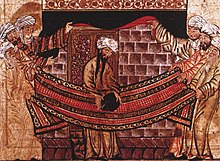
Muhammad's father, Abdullah, died almost six months before he was born.[56] According to Islamic tradition, soon after birth he was sent to live with a Bedouin family in the desert, as desert life was considered healthier for infants; some western scholars reject this tradition's historicity.[57] Muhammad stayed with his foster-mother, Halimah bint Abi Dhuayb, and her husband until he was two years old. At the age of six, Muhammad lost his biological mother Amina to illness and became an orphan.[57][58] For the next two years, until he was eight years old, Muhammad was under the guardianship of his paternal grandfather Abd al-Muttalib, of the Banu Hashim clan until his death. He then came under the care of his uncle Abu Talib, the new leader of the Banu Hashim.[6] According to Islamic historian William Montgomery Watt there was a general disregard by guardians in taking care of weaker members of the tribes in Mecca during the 6th century, "Muhammad's guardians saw that he did not starve to death, but it was hard for them to do more for him, especially as the fortunes of the clan of Hashim seem to have been declining at that time."[59]
In his teens, Muhammad accompanied his uncle on Syrian trading journeys to gain experience in commercial trade.[59] Islamic tradition states that when Muhammad was either nine or twelve while accompanying the Meccans' caravan to Syria, he met a Christian monk or hermit named Bahira who is said to have foreseen Muhammad's career as a prophet of God.[60]
Little is known of Muhammad during his later youth as available information is fragmented, making it difficult to separate history from legend.[59] It is known that he became a merchant and "was involved in trade between the Indian Ocean and the Mediterranean Sea."[61] Due to his upright character he acquired the nickname "al-Amin" (Arabic: الامين), meaning "faithful, trustworthy" and "al-Sadiq" meaning "truthful"[62] and was sought out as an impartial arbitrator.[11][63] His reputation attracted a proposal in 595 from Khadijah, a successful businesswoman. Muhammad consented to the marriage, which by all accounts was a happy one.[61]
Several years later, according to a narration collected by historian Ibn Ishaq, Muhammad was involved with a well-known story about setting the Black Stone in place in the wall of the Kaaba in 605 CE. The Black Stone, a sacred object, was removed during renovations to the Kaaba. The Meccan leaders could not agree which clan should return the Black Stone to its place. They decided to ask the next man who came through the gate to make that decision; that man was the 35-year-old Muhammad. This event happened five years before the first revelation by Gabriel to him. He asked for a cloth and laid the Black Stone in its center. The clan leaders held the corners of the cloth and together carried the Black Stone to the right spot, then Muhammad laid the stone, satisfying the honor of all.[64][65]
Beginnings of the Quran
Recite in the name of your Lord who created—Created man from a clinging substance. Recite, and your Lord is the most Generous—Who taught by the pen—Taught man that which he knew not.
Muhammad began to pray alone in a cave named Hira on Mount Jabal al-Nour, near Mecca for several weeks every year.[66][67] Islamic tradition holds that during one of his visits to that cave, in the year 610 the angel Gabriel appeared to him and commanded Muhammad to recite verses that would be included in the Quran.[68] Consensus exists that the first Quranic words revealed were the beginning of Quran 96:1.[69]
Muhammad was deeply distressed upon receiving his first revelations. After returning home, Muhammad was consoled and reassured by Khadijah and her Christian cousin, Waraqah ibn Nawfal.[70] He also feared that others would dismiss his claims as being possessed. Shi'a tradition states Muhammad was not surprised or frightened at Gabriel's appearance; rather he welcomed the angel, as if he was expected.[g] The initial revelation was followed by a three-year pause (a period known as fatra) during which Muhammad felt depressed and further gave himself to prayers and spiritual practices.[69] When the revelations resumed he was reassured and commanded to begin preaching: "Thy Guardian-Lord hath not forsaken thee, nor is He displeased."[71][72][73]

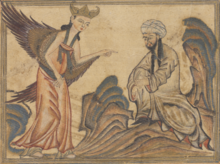
Sahih Bukhari narrates Muhammad describing his revelations as "sometimes it is (revealed) like the ringing of a bell". Aisha reported, "I saw the Prophet being inspired Divinely on a very cold day and noticed the sweat dropping from his forehead (as the Inspiration was over)".[74] According to Welch these descriptions may be considered genuine, since they are unlikely to have been forged by later Muslims.[11] Muhammad was confident that he could distinguish his own thoughts from these messages.[75] According to the Quran, one of the main roles of Muhammad is to warn the unbelievers of their eschatological punishment (Quran 38:70,[76] Quran 6:19).[77] Occasionally the Quran did not explicitly refer to Judgment day but provided examples from the history of extinct communities and warns Muhammad's contemporaries of similar calamities.[78] Muhammad did not only warn those who rejected God's revelation, but also dispensed good news for those who abandoned evil, listening to the divine words and serving God. Muhammad's mission also involves preaching monotheism: The Quran commands Muhammad to proclaim and praise the name of his Lord and instructs him not to worship idols or associate other deities with God.[78]
The key themes of the early Quranic verses included the responsibility of man towards his creator; the resurrection of the dead, God's final judgment followed by vivid descriptions of the tortures in Hell and pleasures in Paradise, and the signs of God in all aspects of life. Religious duties required of the believers at this time were few: belief in God, asking for forgiveness of sins, offering frequent prayers, assisting others particularly those in need, rejecting cheating and the love of wealth (considered to be significant in the commercial life of Mecca), being chaste and not committing female infanticide.[11]
Opposition

According to Muslim tradition, Muhammad's wife Khadija was the first to believe he was a prophet.[79] She was followed by Muhammad's ten-year-old cousin Ali ibn Abi Talib, close friend Abu Bakr, and adopted son Zaid.[79] Around 613, Muhammad began to preach to the public.[8][80] Most Meccans ignored and mocked him, though a few became his followers. There were three main groups of early converts to Islam: younger brothers and sons of great merchants; people who had fallen out of the first rank in their tribe or failed to attain it; and the weak, mostly unprotected foreigners.[81]
According to Ibn Saad, opposition in Mecca started when Muhammad delivered verses that condemned idol worship and the polytheism practiced by the Meccan forefathers.[82] However, the Quranic exegesis maintains that it began as Muhammad started public preaching.[83] As his followers increased, Muhammad became a threat to the local tribes and rulers of the city, whose wealth rested upon the Kaaba, the focal point of Meccan religious life that Muhammad threatened to overthrow. Muhammad's denunciation of the Meccan traditional religion was especially offensive to his own tribe, the Quraysh, as they were the guardians of the Kaaba.[81] Powerful merchants attempted to convince Muhammad to abandon his preaching; he was offered admission to the inner circle of merchants, as well as an advantageous marriage. He refused both of these offers.[81]
Have We not made for him two eyes? And a tongue and two lips? And have shown him the two ways? But he has not broken through the difficult pass. And what can make you know what is the difficult pass? It is the freeing of a slave. Or feeding on a day of severe hunger; an orphan of near relationship, or a needy person in misery. And then being among those who believed and advised one another to patience and advised one another to mercy.
— Quran (90:8–17)
Tradition records at great length the persecution and ill-treatment towards Muhammad and his followers.[11] Sumayyah bint Khayyat, a slave of a prominent Meccan leader Abu Jahl, is famous as the first martyr of Islam; killed with a spear by her master when she refused to give up her faith. Bilal, another Muslim slave, was tortured by Umayyah ibn Khalaf who placed a heavy rock on his chest to force his conversion.[84][85]
In 615, some of Muhammad's followers emigrated to the Ethiopian Kingdom of Aksum and founded a small colony under the protection of the Christian Ethiopian emperor Aṣḥama ibn Abjar.[11] Ibn Sa'ad mentions two separate migrations. According to him, most of the Muslims returned to Mecca prior to Hijra, while a second group rejoined them in Medina. Ibn Hisham and Tabari, however, only talk about one migration to Ethiopia. These accounts agree that Meccan persecution played a major role in Muhammad's decision to suggest that a number of his followers seek refuge among the Christians in Abyssinia. According to the famous letter of ʿUrwa preserved in al-Tabari, the majority of Muslims returned to their native town as Islam gained strength and as high ranking Meccans, such as Umar and Hamzah, converted.[86]
However, there is a completely different story on the reason why the Muslims returned from Ethiopia to Mecca. According to this account—initially mentioned by Al-Waqidi then rehashed by Ibn Sa'ad and Tabari, but not by Ibn Hisham and not by Ibn Ishaq.[11] Muhammad, desperately hoping for an accommodation with his tribe, pronounced a verse acknowledging the existence of three Meccan goddesses considered to be the daughters of Allah. Muhammad retracted the verses the next day at the behest of Gabriel, claiming that the verses were whispered by the devil himself. Instead, a ridicule of these gods was offered.[87][h][i] This episode, known as "The Story of the Cranes," is also known as "Satanic Verses". According to the story, this led to a general reconciliation between Muhammad and the Meccans, and the Abyssinia Muslims began to return home. When they arrived Gabriel had informed Muhammad that the two verses were not part of the revelation, but had been inserted by Satan. Notable scholars at the time argued against the historic authenticity of these verses and the story itself on various grounds.[88][11][j] Al-Waqidi was severely criticized by Islamic scholars such as Malik ibn Anas, al-Shafi'i, Ahmad ibn Hanbal, Al-Nasa'i, al-Bukhari, Abu Dawood, Al-Nawawi and others as a liar and forger.[89][90][91][92] Later, the incident received some acceptance among certain groups, though strong objections to it continued onwards past the tenth century. The objections continued until rejection of these verses and the story itself eventually became the only acceptable orthodox Muslim position.[93]
In 616 (or 617), the leaders of Makhzum and Banu Abd-Shams, two important Quraysh clans, declared a public boycott against Banu Hashim, their commercial rival, to pressure it into withdrawing its protection of Muhammad. The boycott lasted three years but eventually collapsed as it failed in its objective.[94][95] During this time, Muhammad was able to preach only during the holy pilgrimage months in which all hostilities between Arabs were suspended.
Isra and Mi'raj
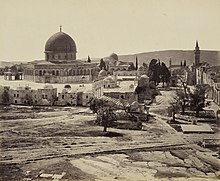
Islamic tradition states that in 620, Muhammad experienced the Isra and Mi'raj, a miraculous night-long journey said to have occurred with the angel Gabriel. At the journey's beginning, the Isra, he is said to have traveled from Mecca on a winged steed to "the farthest mosque." Later, during the Mi'raj, Muhammad is said to have toured heaven and hell, and spoke with earlier prophets, such as Abraham, Moses, and Jesus.[citation needed] Ibn Ishaq, author of the first biography of Muhammad, presents the event as a spiritual experience; later historians, such as Al-Tabari and Ibn Kathir, present it as a physical journey.[citation needed]
Some western scholars[who?] hold that the Isra and Mi'raj journey traveled through the heavens from the sacred enclosure at Mecca to the celestial al-Baytu l-Maʿmur (heavenly prototype of the Kaaba); later traditions indicate Muhammad's journey as having been from Mecca to Jerusalem.[97][page needed]
Last years before Hijra
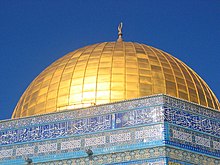
Muhammad's wife Khadijah and uncle Abu Talib both died in 619, the year thus being known as the "Year of Sorrow". With the death of Abu Talib, leadership of the Banu Hashim clan passed to Abu Lahab, a tenacious enemy of Muhammad. Soon afterward, Abu Lahab withdrew the clan's protection over Muhammad. This placed Muhammad in danger; the withdrawal of clan protection implied that blood revenge for his killing would not be exacted. Muhammad then visited Ta'if, another important city in Arabia, and tried to find a protector, but his effort failed and further brought him into physical danger.[11][95] Muhammad was forced to return to Mecca. A Meccan man named Mut'im ibn Adi (and the protection of the tribe of Banu Nawfal) made it possible for him to safely re-enter his native city.[11][95]
Many people visited Mecca on business or as pilgrims to the Kaaba. Muhammad took this opportunity to look for a new home for himself and his followers. After several unsuccessful negotiations, he found hope with some men from Yathrib (later called Medina).[11] The Arab population of Yathrib were familiar with monotheism and were prepared for the appearance of a prophet because a Jewish community existed there.[11] They also hoped, by the means of Muhammad and the new faith, to gain supremacy over Mecca; the Yathrib were jealous of its importance as the place of pilgrimage. Converts to Islam came from nearly all Arab tribes in Medina; by June of the subsequent year, seventy-five Muslims came to Mecca for pilgrimage and to meet Muhammad. Meeting him secretly by night, the group made what is known as the "Second Pledge of al-'Aqaba", or, in Orientalists' view, the "Pledge of War".[99] Following the pledges at Aqabah, Muhammad encouraged his followers to emigrate to Yathrib. As with the migration to Abyssinia, the Quraysh attempted to stop the emigration. However, almost all Muslims managed to leave.[100]
Hijra
The Hijra is the migration of Muhammad and his followers from Mecca to Medina in 622 CE. In June 622, warned of a plot to assassinate him, Muhammad secretly slipped out of Mecca and moved his followers to Medina,[101] 450 kilometres (280 miles) north of Mecca.[102]
Migration to Medina
| Timeline of Muhammad in Medina | ||
|---|---|---|
| 624 | 53–54 | Invasion of Sawiq |
| Al Kudr Invasion | ||
| Raid on Dhu Amarr, Muhammad raids Ghatafan tribes | ||
| 625 | 54–55 | Battle of Uhud: Meccans defeat Muslims |
| Invasion of Hamra al-Asad, successfully terrifies the enemy to cause a retreat | ||
| Assassination of Khaled b. Sufyan | ||
| Tragedy of al Raji and Bir Maona | ||
| Banu Nadir expelled after Invasion | ||
| 626 | 55–56 | Expedition of Badr al-Maw'id, Dhat al-Riqa and Dumat al-Jandal |
| 627 | 56–57 | Battle of the Trench |
| Invasion of Banu Qurayza, successful siege | ||
| 628 | 57–58 | Treaty of Hudaybiyyah, gains access to Kaaba |
| Conquest of the Khaybar oasis | ||
| 629 | 58–59 | First hajj pilgrimage |
| Attack on Byzantine Empire fails: Battle of Mu'tah | ||
| 630 | 59–60 | Bloodless conquest of Mecca |
| Battle of Hunayn | ||
| Siege of Ta'if | ||
| Attack on Byzantine Empire successful: Expedition of Tabuk | ||
| 631 | 60–61 | Rules most of the Arabian peninsula |
| 632 | 61–62 | Farewell hajj pilgrimage |
| Death, on June 8 in Medina | ||
A delegation, consisting of the representatives of the twelve important clans of Medina, invited Muhammad to serve as chief arbitrator for the entire community; due to his status as a neutral outsider.[103][104] There was fighting in Yathrib: primarily the dispute involved its Arab and Jewish inhabitants, and was estimated to have lasted for around a hundred years before 620.[103] The recurring slaughters and disagreements over the resulting claims, especially after the Battle of Bu'ath in which all clans were involved, made it obvious to them that the tribal concept of blood-feud and an eye for an eye were no longer workable unless there was one man with authority to adjudicate in disputed cases.[103] The delegation from Medina pledged themselves and their fellow-citizens to accept Muhammad into their community and physically protect him as one of themselves.[11]
Muhammad instructed his followers to emigrate to Medina, until nearly all his followers left Mecca. Being alarmed at the departure, according to tradition, the Meccans plotted to assassinate Muhammad. With the help of Ali, Muhammad fooled the Meccans watching him, and secretly slipped away from the town with Abu Bakr.[105] By 622, Muhammad emigrated to Medina, a large agricultural oasis. Those who migrated from Mecca along with Muhammad became known as muhajirun (emigrants).[11]
Establishment of a new polity
Among the first things Muhammad did to ease the longstanding grievances among the tribes of Medina was to draft a document known as the Constitution of Medina, "establishing a kind of alliance or federation" among the eight Medinan tribes and Muslim emigrants from Mecca; this specified rights and duties of all citizens, and the relationship of the different communities in Medina (including the Muslim community to other communities, specifically the Jews and other "Peoples of the Book").[103][104] The community defined in the Constitution of Medina, Ummah, had a religious outlook, also shaped by practical considerations and substantially preserved the legal forms of the old Arab tribes.[11]
The first group of converts to Islam in Medina were the clans without great leaders; these clans had been subjugated by hostile leaders from outside.[106] This was followed by the general acceptance of Islam by the pagan population of Medina, with some exceptions. According to Ibn Ishaq, this was influenced by the conversion of Sa'd ibn Mu'adh (a prominent Medinan leader) to Islam.[107] Medinans who converted to Islam and helped the Muslim emigrants find shelter became known as the ansar (supporters).[11] Then Muhammad instituted brotherhood between the emigrants and the supporters and he chose Ali as his own brother.[108]


